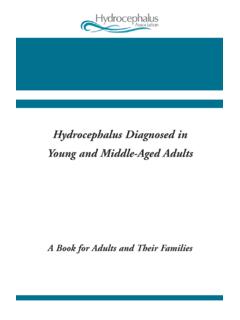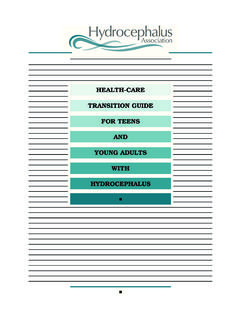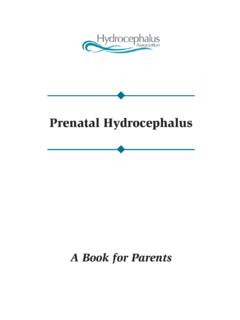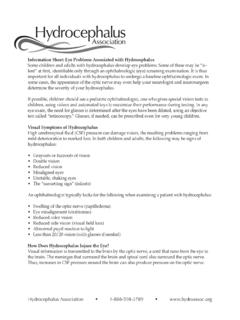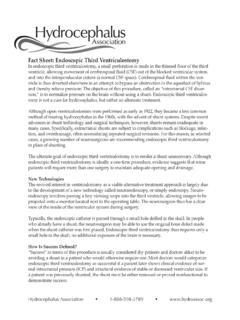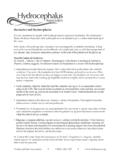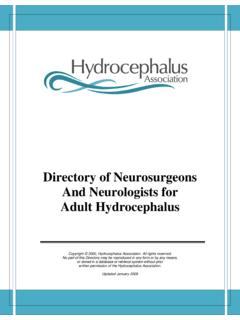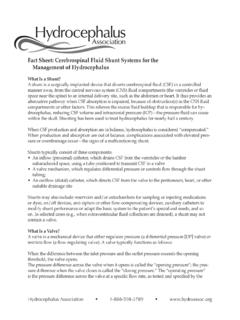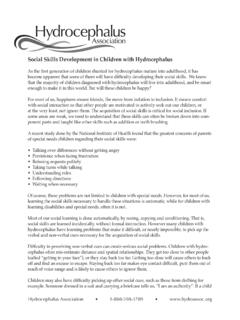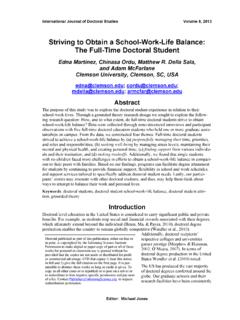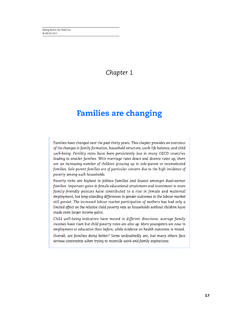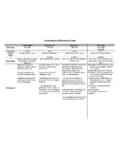Transcription of About Normal Pressure Hydrocephalus (NPH)
1 About Normal Pressure Hydrocephalus (NPH)A Book for Adults and Their families A BOOK FOR ADULTS AND THEIR FAMILIES1 About Normal Pressure Hydrocephalus A Book for Adults and Their families was written for adults with NPH, their fami-lies, friends and caregivers with the intention of providing infor-mation About the diagnosis and treatment of adult-onset Normal Pressure Hydrocephalus (NPH). It is a companion piece to our booklet About Hydrocephalus A Book for families , the most widely distributed resource on infant and childhood Hydrocephalus in the United States. It is our belief that individuals and families dealing with the complex issue of adult-onset NPH must educate themselves About the condition in order to make informed decisions regard-ing treatment and care. While each case differs, the information presented in this booklet is intended to give a general overview of the condition without making judgments or recommendations for individual care.
2 For making clinical decisions, patients must rely on the guidance and recommendations of the clinicians providing their Pressure Hydrocephalus (NPH)ForewordHydrocephalus is a condition characterized by the expansion of the cavities or ventricles in the brain, caused by an abnormal accu-mulation of cerebrospinal fluid (CSF). Hydrocephalus can develop with high or Normal CSF Pressure . Normal Pressure hydrocepha-lus (NPH), originally described by Salomon Hakim, MD, PhD, in 1964, is a clinical condition which principally affects the elderly. It is characterized by a triad of symptoms: motor disturbances (mostly gait impairment), incontinence and dementia, associated with ventricular enlargement in the absence of elevated intracranial Pressure . The diagnosis of NPH does not require all three symp-toms to be 50 years after the original description of NPH, there still remain many unknowns, including its diagnostic criteria.
3 It is not uncommon to find many of the symptoms of NPH in the elderly. These may occur as an isolated finding or associated with other diseases. Changes in some of the intellectual functions are expected to occur during the process of aging in the same way that other physiologic functions of the body become altered with advancing age. In spite of all this, NPH is a known and unique clinical entity justifying its own differential diagnosis with other brain atrophies. There is great importance in identifying patients who have NPH and had previously been diagnosed as hopeless cases of degenerative brain disease, Alzheimer s or Parkinson s dis-ease, since there is the opportunity to provide them with a treatment for NPH that will allow them to have a better quality of the last years, much has been learned to help provide a more accurate diagnosis and better treatment for NPH.
4 The fami-lies of patients who might have NPH should be well informed of the symptoms which are characteristic of this clinical entity, since it is with them that the process of making a diagnosis starts. The families should be encouraged to take a first step, since many patients with NPH have experienced miraculous recoveries after treatment and are now living much fuller BOOK FOR ADULTS AND THEIR FAMILIES3My family has been very involved in the field of Hydrocephalus for many years and we have seen many persons recover dramati-cally after being treated for NPH. The most rewarding experience has always been to help someone with NPH. Even though some-times a patient might not recover after treatment as was expected, the results are many times very rewarding and definitely worth the effort. As has been previously said, There is life after NPH. Carlos Hakim, PhDBecause some of the symptoms of NPH can appear similar to Alzheimer s or Parkinson s or are often associated with the aging process, NPH can be misdiagnosed or go undiagnosed for years.
5 Milt Newman went 13 years before being diagnosed with NPH and successfully treated with a shunt. The difference in how I feel is like night and day. Now I m living; I wasn t living before. I waited for my wife Phyllis to do everything for me. Now I can do things I couldn t do before. dr. milt newman4 Normal Pressure Hydrocephalus (NPH)What Is Hydrocephalus ? Hydrocephalus is a condition characterized by an abnormal ac-cumulation of cerebrospinal fluid (CSF) or spinal fluid within cavities called ventricles that are inside the brain. CSF surrounds the brain and spinal cord. The functions of CSF include physi-cal support or cushioning of the brain, excretion of some waste products and distribution of important substances within the central nervous system. The average adult produces About one pint (500 cc) of clear spinal fluid daily. When the circulatory path of the CSF is blocked, fluid begins to accumulate, causing the ventricles to enlarge and the Pressure inside the head to increase, resulting in Hydrocephalus .
6 What Is Normal Pressure Hydrocephalus ? Normal Pressure Hydrocephalus (NPH) is an accumulation of cerebrospinal fluid that causes the ventricles in the brain to be-come enlarged, sometimes with little or no increase in intracranial Pressure (ICP). It is most commonly seen in older adults, and is accompanied by some or all of the following triad of symptoms: Gait disturbances Mild dementia Impaired bladder control In most cases of NPH, it is not clear what causes the CSF absorptive pathways to become blocked. The name Normal Pressure Hydrocephalus came out of Dr. Salomon Hakim s 1964 paper describing certain cases of hydro-cephalus where a triad of neurologic symptoms occurred in the presence of Normal CSF Pressure . This was before continuous Pressure -recording techniques were available. We now know that the phrase Normal Pressure is misleading, because many pa-tients have fluctuations in CSF Pressure ranging from high to nor-A BOOK FOR ADULTS AND THEIR FAMILIES5 Arachnoid villiLateral ventricleSubarachnoid spaceSagittal sinusAqueduct of SylviusChoroid plexusFourth ventricleThird ventriclemal to low.
7 However, Normal Pressure Hydrocephalus , or NPH, continues to be the common name for the condition. What Causes Normal Pressure Hydrocephalus ? The majority of cases of NPH are idiopathic, meaning of un-known cause (also known as primary NPH). NPH can also develop as the result of a known cause, in which case it is referred to as secondary NPH. Some of these causes are head injury, cranial surgery, subarachnoid hemorrhage, tumor or cysts, as well as subdural hematomas, bleeding during surgery, Cerebrospinal fluid (CSF) circulatory pathway: The drawing shows a view of the brain. The black arrows show the major pathway of CSF flow. The gray arrows show additional pathways. 6 Normal Pressure Hydrocephalus (NPH)meningitis and other brain infections. All of these predisposing conditions can cause inflammation that affects the CSF pathways, impeding CSF flow. What Are the Symptoms?
8 Normal Pressure Hydrocephalus is usually characterized by a triad of symptoms: gait disturbance (difficulty walking), mild dementia and impaired bladder control. These symptoms may not occur all at the same time, and sometimes only one or two symptoms are present. Gait disturbances range in severity from mild imbalance to the inability to stand or walk at all. Gait is described as a magnetic gait, often wide-based, short-stepped, slow and shuffling. People with NPH may have trouble picking up their feet, making stairs and curbs difficult and frequently resulting in falls. They may also have difficulty turning around, and turn very slowly with multiple little steps. Gait disturbance is often the most pronounced symptom and the first to become apparent. Mild dementia can be described as a loss of interest in daily activities, forgetfulness, difficulty dealing with routine tasks and The placement of my shunt provides me with new hope, physical balance and freedom from falling, allowing me to live a Normal lifestyle including visiting family, travel and serving as an arbitrator.
9 Dr. james o gradyA BOOK FOR ADULTS AND THEIR FAMILIES7short-term memory loss. The cognitive symptoms associated with NPH are usually less severe than full-blown dementia, and are often overlooked for years or accepted as an inevitable consequence of aging. People with NPH do not usually lose language skills, but they may be less aware of their deficits than those around them, and may even deny that there are any problems. Not all individuals have an obvious cognitive impair-ment. In mildly affected cases, conversational skills may be preserved and thinking abilities may be relatively unchanged. In some cases, cognitive changes may only be detectable with formal neuropsychological testing. Impairment in bladder control is usually characterized by urinary frequency and urgency in mild cases, whereas a com-plete loss of bladder control (urinary incontinence) can occur in more severe cases.
10 Urinary frequency is the need to urinate more often than usual, sometimes as often as every one to two hours. Urinary urgency is a strong, immediate sensation of the need to urinate. This urge is sometimes so strong that it cannot be held back, resulting in incontinence. In very rare cases, fecal incontinence may occur. Some people never display signs of bladder problems. Because the triad of symptoms are often associated with the aging process in general, and a majority of the NPH population is older than 60 years, people often assume that they must live with the problems and adapt to the changes occurring within their bod-ies as they age. Symptoms of NPH can also resemble those of other conditions affecting the elderly. For example, the cognitive deficits of NPH can resemble those associated with early Alzheimer s, and the gait distur-bances of NPH can look similar to those of Parkinson s.
